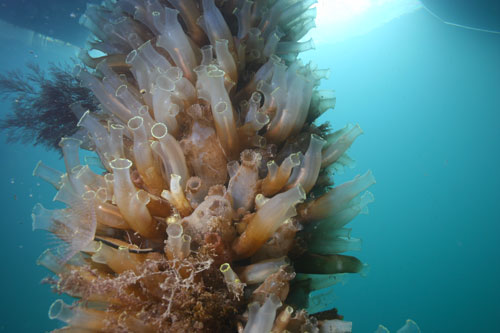Ciona intestinalis (sea squirt)

Ciona intestinalis is a solitary ascidian. This marine invertebrate belongs to the subphylum Urochordata (Tunicates). Appendicularia, Thaliaceae and Ascidiacea constitute the three Urochordata classes. This ascidian is widespread, found along European coasts along the Atlantic and Mediterranean coasts as well as in many other temperate regions.
photo / Y. Fontana
EMBRC expertise:
Access
- Can be found in abundance during most of the year in marinas.
- Wild adults settled on collectors or flower pots immersed in marinas can be harvested and shipped.
- The life cycle can be completed in the laboratory (development and reproduction in 2 to 3 months) with the production of hundreds of gametes and in vitro fertilisation carried out in beakers. Requires concomitant production of microalgae to feed the larvae.
- Laboratory cultures of wild lines to provide healthy broodstock; 15th generation lines for type B (and 9th generation endogamous lines); 2nd generation lines for type A
Available tools
- This organism is hermaphroditic but external fertilisation is allogamous. The life cycle is very short and varies with temperature: 8 days at 15°C and less than 2 days at 29°C.
- The gametes are easy to collect and in vitro fertilisation is easy to perform in the laboratory.
- Embryo development occurs externally (no brooding), making embryos easily and quickly (<24 h) accessible for experiments: at 18°C, a swimming larva hatches 18 h after fertilisation and then, after several days, settles on a surface and undergoes metamorphosis.
- Precursors to various tissues have been inventoried and mapped in the embryo because embryonic development is synchronous with invariable cell lineages. Larvae are made up of only 2600 cells organised into a few different tissue types that are easy to observe, including 36 muscle cells and 40 notochord cells.
- The embryos are transparent as are the adults and both are thus suitable for cell imaging techniques, in situ in toto hybridisation, and immunohistochemistry.
- They are easy to handle and functional gene analysis is straightforward. Many molecular tools have been developed: micro-injection of morpholinos or mRNA at the one- or two-cell stage, electroporation of plasmids to obtain hundreds or even thousands of transgenic embryos using simple electric pulse methods and modification of the genome with the use of TALEN and CRISPR-Cas9 methods.
Scientific advantages of this model organism
- Ciona intestinalis has been a model organism for the study of developmental processes in chordates since the 19th century.
- Urochordates (Tunicates), along with cephalochordates and vertebrates, form the phylum Chordata. Chordates are characterised by the presence of a dorsal neural tube and a notochord. This body plan is shared by all urochordates but only at the larval stage, with the exception of adult appendicularians which retain their tail. Upon metamorphosis, the larval notochord, tail and neural tube disappear. Adults (sessile; solitary or colonial) have two siphons, an incurrent buccal siphon and an excurrent atrial siphon, to filter seawater. They are sheathed in a tunic secreted by the epidermis. This tunic contains cellulose, an exceptional occurrence in the animal kingdom.
- Tunicates hold a key evolutionary position because they are considered to be the invertebrates the most closely related to vertebrates. Their genome has not undergone total duplication, facilitating functional gene analyses due to the near absence of redundancy. Ciona intestinalis has proved to be very practical for characterising gene regulatory networks (GRN) to determine structure and function. The existence of other ascidian species as model organisms offers the opportunity to carry out evolutionary developmental biology studies of cellular, molecular and genetic mechanisms.
- Two distinct species, type A and type B, have been identified in Ciona intestinalis, offering the opportunity to study the mechanisms of speciation.
Available genetic resources
- The genome of Ciona intestinalis has been sequenced. It is small, with 160 Mb and 14 pairs of chromosomes, and contains 16,000 genes; the genome is compact.
- Genetic markers are available to distinguish type A from type B.
Databases
- ANISEED, Ascidians Network for In Situ Expression and Embryological Data: (62)
- GHOST, Ciona intestinalis genomic and cDNA resources (63)
- Tunicate Portal





